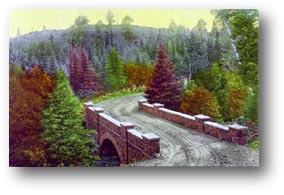

The History of Duluth, Minnesota's Seven Bridges Road
When Snively's road
reopened on July 6th, 1912, it was renamed Amity Parkway and added
nearly 6 miles to the city's growing boulevard system. At its
dedication, Snively recounted the road's
history for the local press.
The new Amity Parkway became a popular destination for tourists and locals alike. Winding its way up into the eastern hills, the route presented many scenic sights of the landscape and rushing creek. Flowers lined many of the drive's turns and curves, and in the autumn, the poplar and birch forests presented spectacular colors for the tourist.

Two early views of stone-arch bridges along Amity Parkway, Duluth, MN. Postcard of Bridge #7 (left) and photograph of Bridge #6 (above), c. 1912.
Satisfied for the time being, Snively moved on again to other things in his life, but would return some two and a half decades later, (this time as the mayor of Duluth) to build the final leg to his road, the segment of the road leading to Hawk Ridge.
Two of the bridges (#8 & #9) fell into
disuse (by automobiles) when the eastern extension  to and along Hawk Ridge was completed in the thirties.
to and along Hawk Ridge was completed in the thirties.
Remnants of these two closely-built bridges still stand along a pedestrian pathway that shoots off from the main road near the last bridge crossed before the road ascends toward Hawk Ridge Nature Reserve.
The remaining seven bridges are still used by vehicle traffic, but years of weather, combined with vandalism, and vehicle accidents have taken their toll.
 Many of the pink granite
cap rocks have been knocked or pushed into the creek below. Large
pieces of the rock facing have been damaged or have begun to erode
away. In some cases, entire chunks of the span have been separated
from the main structure. But despite these maladies the bridges
remain structurally sound.
Many of the pink granite
cap rocks have been knocked or pushed into the creek below. Large
pieces of the rock facing have been damaged or have begun to erode
away. In some cases, entire chunks of the span have been separated
from the main structure. But despite these maladies the bridges
remain structurally sound.